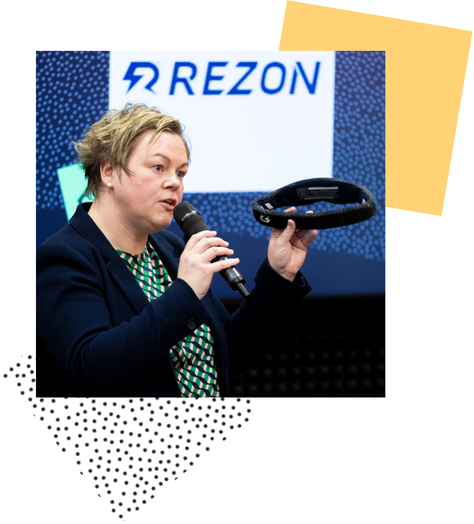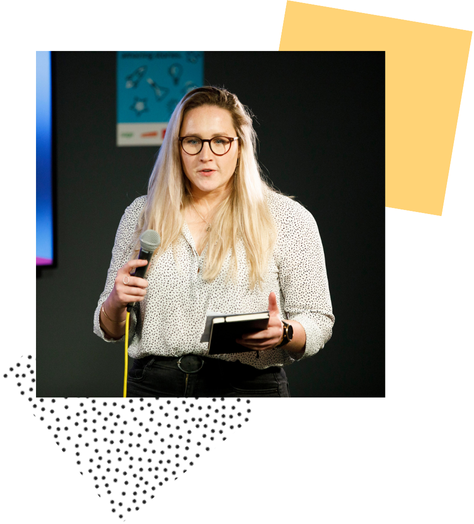Every year, around 0.2% of business funding goes to black women. Last year, when I set out with my co-founder Joycelyn to raise £360k while I had a very visible baby bump, we knew we’d have a serious fight on our hands.
In an environment where young black women aren’t funded, we’ve managed to smash our target and raise over £510k by our deadline. We even found ourselves in the position of turning down some money that wasn’t the best strategic move for our long term vision.
Now we’ve opened that door, we intend to hold it wide open for other founders who look like us.
We’ve had hundreds of questions from fellow underrepresented founders about the fundraising process, so I’m writing this article to tell you how we did it and pass on the tips we wish we had a year ago.
Our journey to investment
May 2017: The idea begins to grow
We were working on Afrocenchix with no salary and realised we needed a cash injection. I was tutoring, contracting and generally side hustling to pay the bills and we were massively overstretched.
We had our first advisory meeting with David McQueen (after a year of working to get his attention on Twitter) who encouraged us to raise investment and start on a basic pitch deck.
David later invited us to join his Build Legacy group when it launched in 2018. Several of our angel investors came from this group.
February 2018: Pre-accelerator and endless meetings
We were selected for FastForward, London’s pre-accelerator programme – Your Startup, Your Story were working with them to improve the diversity in their pipeline. Through this, we had about 19 meetings with potential investors, but no money was committed. We had a huge amount to learn.
Fortunately for us, Andy Davis, one of the mentors on the programme, took us under his wing. He recommended books like Venture Deals, Shoe Dog and The Facebook Effect, and invited us to join 10×10, his group for black entrepreneurs.
We also met Arlan Hamilton at a fireside chat. After asking an audience question, she offered to speak to us afterwards. She connected us with two of her team members who gave us feedback on our deck. This would later put us in good stead when applying for the Backstage accelerator.
March 2018: The failed crowdfunder
After deciding we didn’t want to raise investment – and being quoted 20% and above for loans – we opted for the crowdfunding route.
When we researched crowdfunding, we were told that we needed to put money behind a crowdfunder and have over 70% of the commitment before we even launched.
We didn’t have a marketing budget, since all of our profit was reinvested into the company. But we figured that great products, loyal customers and an important mission and vision were enough. What could go wrong?
We launched with about 10 people committed to back an initial £500. It wasn’t the £15,000 we had been told was needed to kick things off.
Then it went quiet. And it stayed quiet.
At first, things were looking great. The campaign went viral and we raised £2500 in the first few hours. It was featured on the Indiegogo site, and backers from 12 countries pledged to support us. We were sure we’d hit our target.
Then it went quiet. And it stayed quiet. Our tiny team was still in the kitchen, busy running the company, so we had no capacity to promote the crowdfunding campaign. We aimed to raise £25,000 – after two months we’d only raised £6,657.
Then we ran into another problem. We already needed money to meet demand for our core range, but we’d generated demand for new products and promised them to the trailblazers who backed us. We didn’t raise enough to fulfil that promise, so we had to speed up our fundraising.
During this period, we met CGV for advice. We later discovered that they ended up raising a fund, so they could lead our all black angel round.
As the saying goes, look for money and you’ll get advice. Look for advice and you’ll get money.
April – July 2018: The real work begins
Up to this point, everything was mainly research and preparation. Now we had our vision completely clear: we wanted to give every black and mixed heritage person in the world access to our safe, effective products and scientific education.
We got focused. After getting feedback from February’s meetings and incorporating the lessons learnt from the Backstage team, we had a much better pitch deck. But we still didn’t have the warm introductions that people kept telling us we needed.
We didn’t have the network, so we hustled. We hit every stage we could. We went to Cog X, Startup Grind, The Pitch. Everything. We took part in anything that had investors – anywhere we could ask an audience question to get their attention.
July – August 2018: Fighting investment bias
We started having weekly catchups with Andy from FastForward and tracking our progress on Trello.
We recorded who we were speaking to, what we wanted from the conversation and what was committed. Knowing we had to update Andy was extra motivation to make sure everything was moving. It became as important to get a clear no as a commitment. We needed conclusions, not platitudes.
That summer, we won the KPMG Black Entrepreneurs award. We travelled up to Birmingham – where we had started Afrocenchix – for four rounds of a Midland-wide competition and won VentureFest WM. Were we doing too much? Probably.
We watched pre-revenue white Oxbridge male peers receive millions in investment, only to go on to quit or fail in their startups
The wins were validation that we had a good company, a strong vision and a killer pitch. Yet investors still didn’t seem interested.
Our frustration grew as we watched pre-revenue white Oxbridge male peers receive millions in investment, only to go on to quit or fail in their startups. In the meantime, we were told “the market just isn’t big enough” or “the team lacks experience”, despite the fact we’d spent a decade changing a market valued at £4.2 billion in the UK alone.
We’d become the first afro hair brand to launch in all nine Whole Foods stores the previous summer. We’d sold thousands of bottles to customers in over 22 countries. We kept being told how amazing our product, team and pitch was, yet the money didn’t follow.
Something was wrong and we couldn’t fix it. Doors kept shutting in our faces. What we could do was focus in on the doors in front of us that were slightly ajar.
September 2018: Breaking down data for investors
We examined the Trello board and our spreadsheet. We saw patterns – investors needed hard data on our place in a fragmented industry, but found it hard to navigate our packed data room.
So we arranged an investor evening with data stations. We invited all the serious investors and sent term sheets ahead of time. We created investment packs with one page that included the investment proposition, the term sheet and further information. We laid out our prototypes of the new products and our awards, as well as some good old refreshments – we figured hungry people would not invest in your project!
The evening helped. Some of our investors were clearly reassured just speaking to others considering the proposition. Gary, one of the committed angel investors, was particularly excited and he had plenty of ideas for us.
Again, we didn’t know how important this would be.
October 2018: An unexpected opportunity
I was due to give birth in October and was eager to close the round before I went on leave. It would mean our overstretched core team of three wouldn’t become a team of two – we could hire and grow.
During this time, we were up to £200k committed, but no term sheets had been signed. While considering the investment, Gary sent us information about the WeWork Creator Awards.
The deadline for the awards was only a couple of days away, and we’d decided to stop doing competitions and focus on angels. I told him that we’d look at the competition next year, but he insisted it was worth a shot.
We’d had a few potential investors make an issue of my pregnancy and it was beyond the point where baggy clothes would help
Against all reason, I cleared an afternoon from my diary to do the application, tweak our deck to fit the requirements and edit down our crowdfunding video to meet the application criteria.
We forgot about it until weeks later when Joycelyn and I were invited to the semi-finals – then the final.
We had a great pitch deck because we’d worked on it for so long. We had a good video because we’d crowdfunded (or tried to). We had our pitch perfect because we had done it so many times. We had our documents ready for the due diligence process because we were going through it with angels.
The final was on my due date and we weren’t sure if my bump would get in the way of the judges hearing our pitch. We’d had a few potential investors make an issue of my pregnancy and it was beyond the point where baggy clothes would help. After reading the WeWork values, I was sure they wouldn’t discriminate.
That Thursday, Joycelyn and I prayed backstage as the event opening music played. I took to the stage with Joycelyn, ready to jump win if my waters broke.
After being grilled by the judges, we were beyond shocked to win $360,000!
Nov 2018 – April 2019: The close
After that, the angels who were on the fence either became a yes, or we told them it was a no. We were able to raise £60k from a small selection of black angel investors.
In this crazy period, WeWork flew Joycelyn to New York and she competed against winners from around the world and secured our place at the LA Global Finals, where we won a further $180k (£144k) convertible prize from celebrity judges Ashton Kutcher, Gary Vee, Kristen Green and Sean ‘Diddy’ Coombes.
We were also selected for the inaugural Backstage Capital accelerator from over 1800 applicants.
It took months to close the round and the full funds didn’t arrive until April. That’s about six months from signing the first term sheet to receiving the cash. If it wasn’t for the angel investors swiftly buying shares, that could have been a disaster.
Where are we now? We’re working on raising £3-5 million in late 2020. As fundraising can take such a long time, we’re already having conversations with several of our top choice investors.
On reflection
Venture Capital isn’t for everyone. Even angel investment isn’t necessarily the best route. Set out your vision and roadmap before you start speaking to investors.
If your aims are global, you’ll likely need investment. If you can achieve your mission by reinvesting profits, then that’s the best route to take. Fundraising is draining and time-consuming – only do it if you have to.
Last, the invaluable advice we received along the way was only available to us because they knew we were growing the company and raising investment. Everyone knew we were raising.
We’ve had some criticism over this approach, but in a system that works against us, underrepresented founders need to make themselves seen.
When you do the work to be visible, things start to happen.




